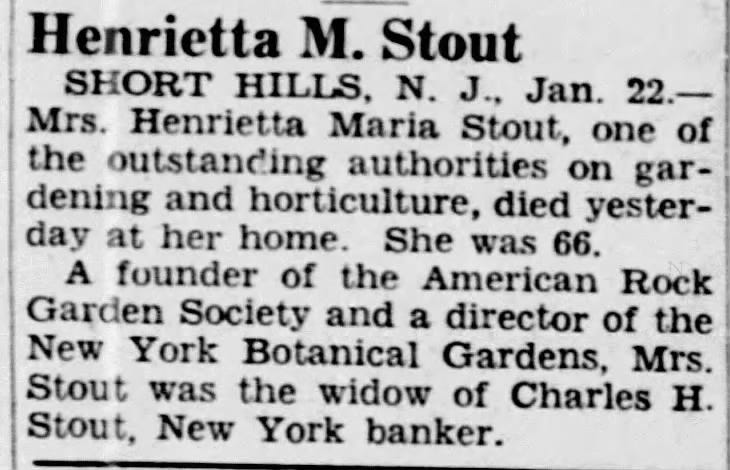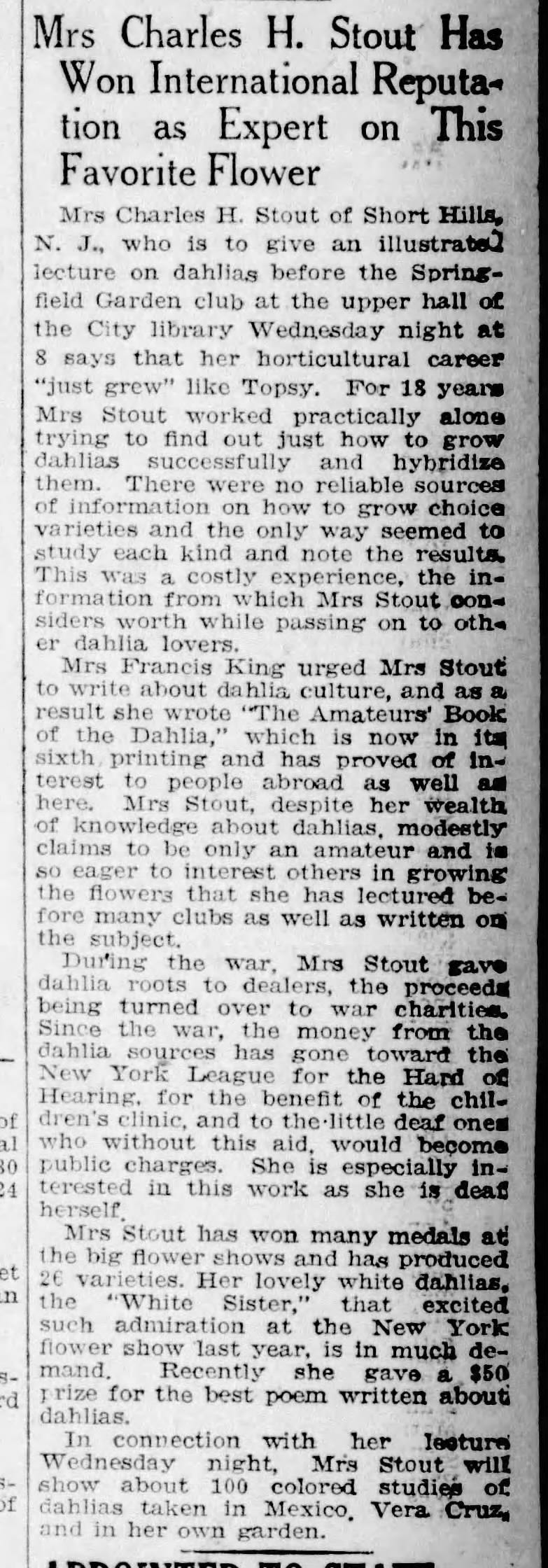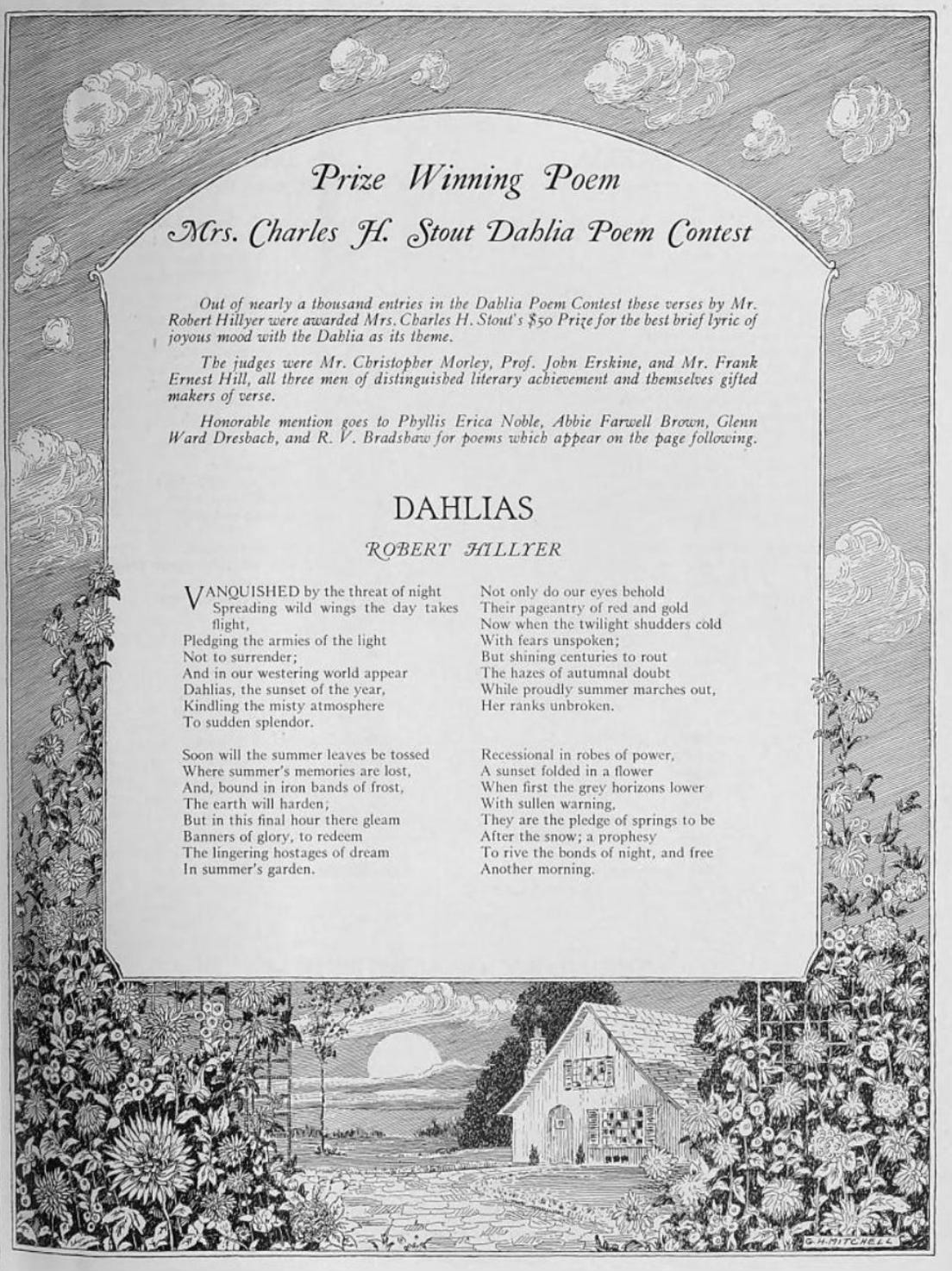Mrs. Charles H. Stout
Dahlias! "Your hoe will become a wand, and beauty will spring from the dead brown earth..."
Have you fallen in love with dahlias? If you have, maybe you already know about Mrs. Charles H. Stout. It seems that in the early 20th century, no one knew as much about dahlias or loved dahlias as fiercely as she did. She wrote a book about them, which is why she’s our latest Lost Lady of Garden Writing.
Her Biography
Henrietta Maria Schroeder Stout was born on October 9, 1875, to Francis and Lucy Schroeder, one of four children.
She grew up in Vermont and, per the census records, completed high school. She applied for a passport in 1898, stating her intention to travel for two years. On her passport, she was described as 5 feet 3 inches tall with a long nose, round chin, gray eyes, light brown hair, and a fair complexion. She married Charles H. Stout in 1899, so perhaps she was preparing for a honeymoon trip when she got her passport?
In the 1920 census, she and her husband, a banker, lived in New Jersey. They had one son, aged 16, and their household included four maids. By the 1930 census, Henrietta was a widow—Charles died in 1928—with an older adopted daughter (33 years old) and just two maids.
Henrietta died in New Jersey in January 1942, aged 66. Her obituary was short and to the point, but didn’t mention anything about dahlias!
Her Book, Her Passion
Henrietta (that’s how I’m going to refer to her) wrote The Amateur’s Book of the Dahlia in 1922. It received high praise with an introduction written by Mrs. Francis King, who seemed to have helped many authors publish gardening books in the early twentieth century.
Mrs. King wrote in the introduction:
“The chapters of this book, based as they are on sound knowledge, spiced with humour, fortified by experience and by experiment—a totally different thing—will, I am convinced, do much for the progress of dahlia growing and hybridizing. But the general impression of Mrs. Stout's writing is this. It is not only a cup of knowledge but a cup of delight, one that brims over and whose overflow refreshes and stimulates others in the pursuit of dahlias old and new, in the pursuit of dahlia growing with all its attendant and varied interests. The garden work that flowers in writing means a permanent benefit to the gardening public—and not one of our fine amateurs is better qualified to discourse upon the dahlia, its history, cultivation, and hybridizing than the author of this book.”
The book continued with 15 chapters on everything you’d ever want to know about dahlias. You can read a scanned copy of it online. It takes a few paragraphs to get used to the style, which Mrs. King described as “not only a cup of knowledge but a cup of delight…” and “spiced with humour.”
Here’s an example from the foreword of the book written by Henrietta:
“Plant your seeds and your bulbs, and the great Artist will come down and work with you. Your hoe will become a wand, and beauty will spring from the dead brown earth which you have touched. He will break up the rainbow and paint the blossoms with the pieces; and you will feel a thrill of joy at thought of partnership with Him who made the world so beautiful.”
Mrs. King also noted in the introduction that Henrietta donated all her profits from selling dahlias and lecturing on dahlias.
“The money from the sale of these dahlia roots, and from her own lectures on the dahlia— lectures with beautiful coloured slides—has gone without exception to the support of French war orphans, to the Fund for Devastated France, to the Maisons Claires, and lately some of it to a hospital in Shantung. Mrs. Stout thus remains a consistent amateur of the dahlia, and none will deny that this record glorifies even her superb achievements as a hybridizer and a grower of her special flower.”
I also read an article in a March 1921 edition of The Cincinnati Enquirer about Henrietta going there to give a lecture on “Dahlias: Their History and Culture.” They noted in the article that the proceeds from her lectures “shall go entirely to Mrs. Walter S. Brewster’s fund for the war orphans.” We know Mrs. Brewster as Kate L. Brewster, author of The Little Garden for Little Money.
More Interesting Info
I found more interesting information about Henrietta in an article in the Springfield Daily Republican from May 10, 1925.
Of particular interest is that she worked for 18 plus years growing and hybridizing dahlias, yet always considered herself an amateur and wanted to remain an amateur. That’s perhaps one reason why she donated all her profits from selling dahlias and speaking about them.
And did you notice how they slipped in the information about her contribution to the New York League for the Hard of Hearing? “She was especially interested in this work as she was deaf herself.”
Sponsored a Poetry Contest
In 1925, Henrietta also sponsored a poetry contest, offering a $50 prize for the best poem about dahlias. They were seeking “the best brief lyric of joyous mood with the dahlia as its theme.” They received nearly 1,000 entries.
The winning poem was published in the April 1925 edition of Garden Magazine and Home Builder. And yes, I found it on the internet!
That $50 prize in 1925 was the equivalent of just over $900 today. No wonder so many people entered!
While the whole poem is about dahlias, they are only mentioned in name once: “Dahlias, the sunset of the year, Kindling the misty atmosphere To sudden splendor.” I think Henrietta probably approved of it, though she was not one of the judges.
Remaining Questions
I’ve just barely touched on the life of Henrietta M. Stout but what I’ve read intrigues me.
Two previous women came up in connection with Henrietta—Mrs. Francis King and Kate L. Brewster. It seems there were as many connections between writers back then as there are today. Who else did she know? Or influence? What would it look like to show all the various connections, and how would one ever do that?
What about Henrietta’s deafness? Was it a lifelong condition or one that developed later in life? It didn’t seem to have stopped her from pursuing her passion for dahlias and for teaching and lecturing about them.
Who was her adopted adult daughter, Virginia, who showed up in the 1930 census, age 33? What were the circumstances that compelled Henrietta to adopt her?
What happened to all the dahlias Henrietta hybridized? I found a website called Dahlia Doctor with an article about some of the dahlias she hybridized. In the article, published in 1922, the author also wrote that Henrietta destroyed any dahlia varieties she hybridized that weren’t up to her standards. Those she approved of and named were for sale for around $2 per tuber in the 1920s, which today would be a little over $35 per tuber.
Are some of her hybridized varieties still available today? I don’t know. It would take some time to cross-reference the lists of the dahlias mentioned in the article with lists of what we can buy today.
Is the information in The Amateur’s Book of the Dahlia still useful and accurate today? I would assume that much of the cultural information is still accurate, but as with all these older gardening books, I would never follow the pesticide advice.
The danger—delight?—in doing more research on Henrietta Stout is that I’d soon be wanting to find a few dahlias to try in my garden. After all, what could it hurt to add a new obsession—I mean flower—to my gardening life? So I’ll leave Henrietta at this point, but I’ll always remember her now when I see dahlias in bloom.
And I’ll also think of my hoe as a wand, thanks to her.
Do you know of other women authors of gardening-related books that I should research as Lost Ladies of Garden Writing? Send them my way via a comment or email!
And if you find these articles interesting and think others will, too, please share them and subscribe.
I’ll return with the next Lost Lady of Garden Writing article in two weeks, on May 28th. In the meantime, you can find me in several other places online: my website and blog, The Gardenangelists podcast, and my weekly newsletter, In the Garden With Carol.









I’m loving your series, Carol. It inspires me to research lost ladies of garden writing in my own country, Australia. I wonder what I can find in newspapers here?
What a gal. Yielding my hoe like a wand!!